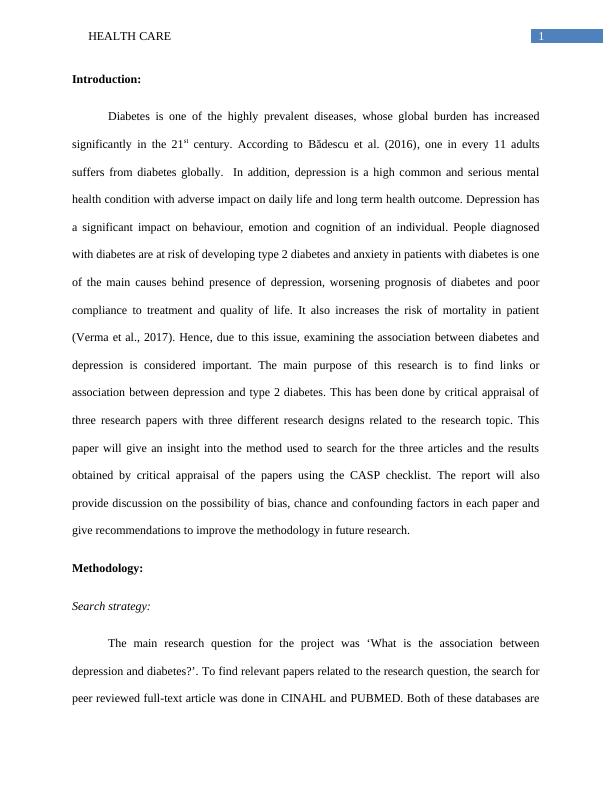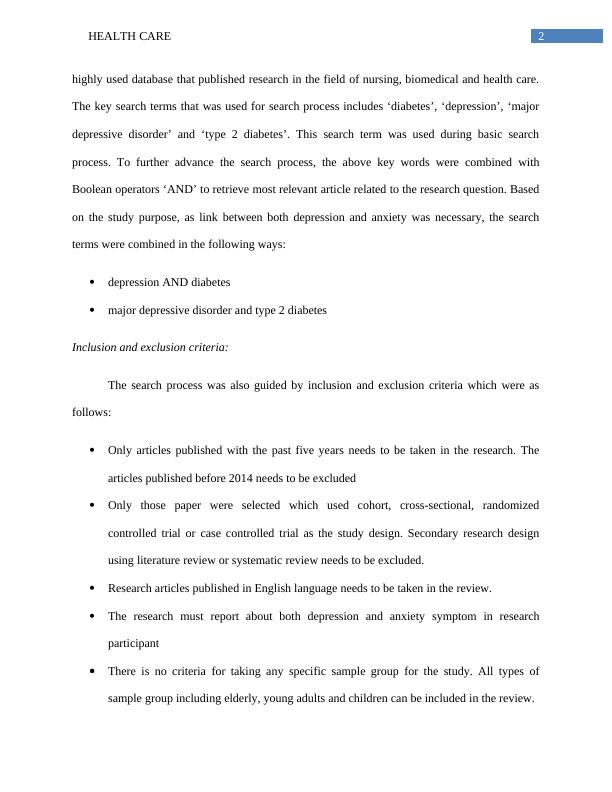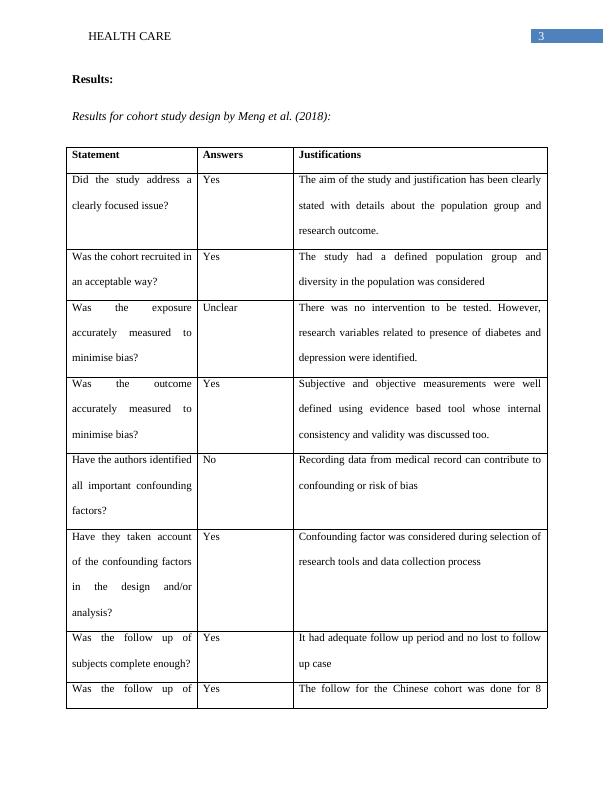Association between Depression and Type 2 Diabetes: A Critical Appraisal
Added on 2023-01-23
12 Pages2552 Words65 Views
Running head: HEALTH CARE
Health care
Name of the student:
Name of the University:
Author’s note
Health care
Name of the student:
Name of the University:
Author’s note

1HEALTH CARE
Introduction:
Diabetes is one of the highly prevalent diseases, whose global burden has increased
significantly in the 21st century. According to Bădescu et al. (2016), one in every 11 adults
suffers from diabetes globally. In addition, depression is a high common and serious mental
health condition with adverse impact on daily life and long term health outcome. Depression has
a significant impact on behaviour, emotion and cognition of an individual. People diagnosed
with diabetes are at risk of developing type 2 diabetes and anxiety in patients with diabetes is one
of the main causes behind presence of depression, worsening prognosis of diabetes and poor
compliance to treatment and quality of life. It also increases the risk of mortality in patient
(Verma et al., 2017). Hence, due to this issue, examining the association between diabetes and
depression is considered important. The main purpose of this research is to find links or
association between depression and type 2 diabetes. This has been done by critical appraisal of
three research papers with three different research designs related to the research topic. This
paper will give an insight into the method used to search for the three articles and the results
obtained by critical appraisal of the papers using the CASP checklist. The report will also
provide discussion on the possibility of bias, chance and confounding factors in each paper and
give recommendations to improve the methodology in future research.
Methodology:
Search strategy:
The main research question for the project was ‘What is the association between
depression and diabetes?’. To find relevant papers related to the research question, the search for
peer reviewed full-text article was done in CINAHL and PUBMED. Both of these databases are
Introduction:
Diabetes is one of the highly prevalent diseases, whose global burden has increased
significantly in the 21st century. According to Bădescu et al. (2016), one in every 11 adults
suffers from diabetes globally. In addition, depression is a high common and serious mental
health condition with adverse impact on daily life and long term health outcome. Depression has
a significant impact on behaviour, emotion and cognition of an individual. People diagnosed
with diabetes are at risk of developing type 2 diabetes and anxiety in patients with diabetes is one
of the main causes behind presence of depression, worsening prognosis of diabetes and poor
compliance to treatment and quality of life. It also increases the risk of mortality in patient
(Verma et al., 2017). Hence, due to this issue, examining the association between diabetes and
depression is considered important. The main purpose of this research is to find links or
association between depression and type 2 diabetes. This has been done by critical appraisal of
three research papers with three different research designs related to the research topic. This
paper will give an insight into the method used to search for the three articles and the results
obtained by critical appraisal of the papers using the CASP checklist. The report will also
provide discussion on the possibility of bias, chance and confounding factors in each paper and
give recommendations to improve the methodology in future research.
Methodology:
Search strategy:
The main research question for the project was ‘What is the association between
depression and diabetes?’. To find relevant papers related to the research question, the search for
peer reviewed full-text article was done in CINAHL and PUBMED. Both of these databases are

2HEALTH CARE
highly used database that published research in the field of nursing, biomedical and health care.
The key search terms that was used for search process includes ‘diabetes’, ‘depression’, ‘major
depressive disorder’ and ‘type 2 diabetes’. This search term was used during basic search
process. To further advance the search process, the above key words were combined with
Boolean operators ‘AND’ to retrieve most relevant article related to the research question. Based
on the study purpose, as link between both depression and anxiety was necessary, the search
terms were combined in the following ways:
depression AND diabetes
major depressive disorder and type 2 diabetes
Inclusion and exclusion criteria:
The search process was also guided by inclusion and exclusion criteria which were as
follows:
Only articles published with the past five years needs to be taken in the research. The
articles published before 2014 needs to be excluded
Only those paper were selected which used cohort, cross-sectional, randomized
controlled trial or case controlled trial as the study design. Secondary research design
using literature review or systematic review needs to be excluded.
Research articles published in English language needs to be taken in the review.
The research must report about both depression and anxiety symptom in research
participant
There is no criteria for taking any specific sample group for the study. All types of
sample group including elderly, young adults and children can be included in the review.
highly used database that published research in the field of nursing, biomedical and health care.
The key search terms that was used for search process includes ‘diabetes’, ‘depression’, ‘major
depressive disorder’ and ‘type 2 diabetes’. This search term was used during basic search
process. To further advance the search process, the above key words were combined with
Boolean operators ‘AND’ to retrieve most relevant article related to the research question. Based
on the study purpose, as link between both depression and anxiety was necessary, the search
terms were combined in the following ways:
depression AND diabetes
major depressive disorder and type 2 diabetes
Inclusion and exclusion criteria:
The search process was also guided by inclusion and exclusion criteria which were as
follows:
Only articles published with the past five years needs to be taken in the research. The
articles published before 2014 needs to be excluded
Only those paper were selected which used cohort, cross-sectional, randomized
controlled trial or case controlled trial as the study design. Secondary research design
using literature review or systematic review needs to be excluded.
Research articles published in English language needs to be taken in the review.
The research must report about both depression and anxiety symptom in research
participant
There is no criteria for taking any specific sample group for the study. All types of
sample group including elderly, young adults and children can be included in the review.

3HEALTH CARE
Results:
Results for cohort study design by Meng et al. (2018):
Statement Answers Justifications
Did the study address a
clearly focused issue?
Yes The aim of the study and justification has been clearly
stated with details about the population group and
research outcome.
Was the cohort recruited in
an acceptable way?
Yes The study had a defined population group and
diversity in the population was considered
Was the exposure
accurately measured to
minimise bias?
Unclear There was no intervention to be tested. However,
research variables related to presence of diabetes and
depression were identified.
Was the outcome
accurately measured to
minimise bias?
Yes Subjective and objective measurements were well
defined using evidence based tool whose internal
consistency and validity was discussed too.
Have the authors identified
all important confounding
factors?
No Recording data from medical record can contribute to
confounding or risk of bias
Have they taken account
of the confounding factors
in the design and/or
analysis?
Yes Confounding factor was considered during selection of
research tools and data collection process
Was the follow up of
subjects complete enough?
Yes It had adequate follow up period and no lost to follow
up case
Was the follow up of Yes The follow for the Chinese cohort was done for 8
Results:
Results for cohort study design by Meng et al. (2018):
Statement Answers Justifications
Did the study address a
clearly focused issue?
Yes The aim of the study and justification has been clearly
stated with details about the population group and
research outcome.
Was the cohort recruited in
an acceptable way?
Yes The study had a defined population group and
diversity in the population was considered
Was the exposure
accurately measured to
minimise bias?
Unclear There was no intervention to be tested. However,
research variables related to presence of diabetes and
depression were identified.
Was the outcome
accurately measured to
minimise bias?
Yes Subjective and objective measurements were well
defined using evidence based tool whose internal
consistency and validity was discussed too.
Have the authors identified
all important confounding
factors?
No Recording data from medical record can contribute to
confounding or risk of bias
Have they taken account
of the confounding factors
in the design and/or
analysis?
Yes Confounding factor was considered during selection of
research tools and data collection process
Was the follow up of
subjects complete enough?
Yes It had adequate follow up period and no lost to follow
up case
Was the follow up of Yes The follow for the Chinese cohort was done for 8

End of preview
Want to access all the pages? Upload your documents or become a member.
Related Documents
Effectiveness of Mindfulness-Based Therapeutic Interventions on Cognitive Functioning and Psychological Health Outcome of the Elderlylg...
|15
|3303
|339
Critical Appraisal Literature Review | Doclg...
|9
|1740
|26
Honey Dressing for Wound Healing in Diabetic Patients: A PICO(t) Analysislg...
|23
|2202
|374
What is Critical Appraisal?lg...
|8
|2005
|15
Critical Appraisal Literature Reviewlg...
|12
|2195
|16
Criteria for evaluating evidence on public healthlg...
|15
|3948
|40
